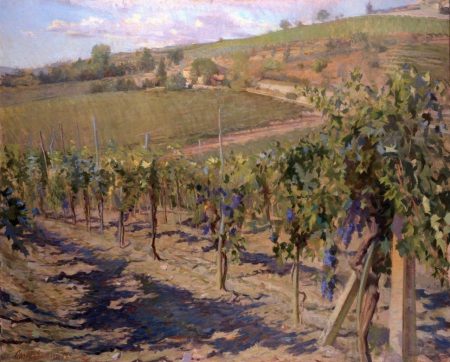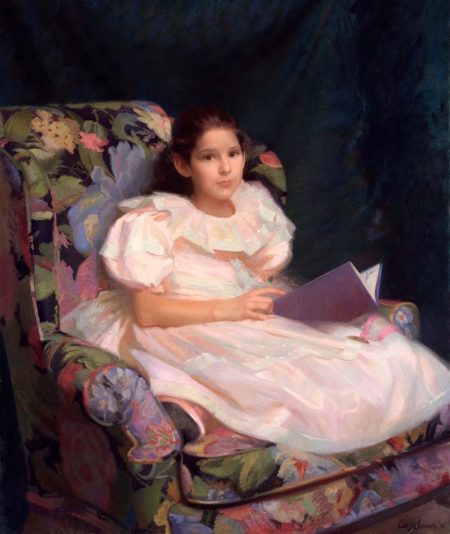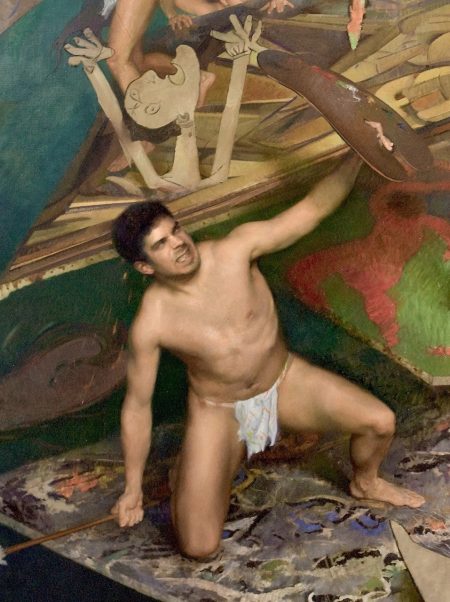The challenge for figurative painting, says Carl Samson, practitioner of same, is that it needs to be relevant to today. He speaks of hoping that his works “give people something they’ve not considered. Give them things to think about. New considerations. Preservation of the natural world. Patina is not everything.”

That’s a large order. It’s also one he fulfills for many viewers in the art he has been making throughout his career. Growing up in the 1960s in small town Ohio, by the time Samson was fourteen he was studying under a local artist and in 1979, at the age of eighteen, he moved to Boston for what he now calls “a unique and rare opportunity to study under one of America’s finest painters and Boston School descendant R.H. Ives Gammell.” He would continue his studies in this country and abroad, focusing on both old masters and important American realists, before settling in Cincinnati 1986.
Samson’s studio now is in Eden Park, in a Queen Anne style house built in 1886 and once home to artists Herman and Bessie Wessel, students of Cincinnati’s preeminent artist of the early 20th century, Frank Duveneck. Duveneck’s easel, in fact, stands in Samson’s crammed front room.
The Wessels added the high-ceilinged studio at the back of the house around 1930, a generous eighteen by twenty-four foot space with windows looking north, east and south. No west light, and “south light is hard to keep up with,” he said.

Samson’s wife, Carol, an art historian, works upstairs here; he has the first floor rooms and the generous studio. They rented the house in 1995 and lived and worked there, bought it in 2000 and continued to use it for their work but moved to a suburb adjacent to Cincinnati (“a more gentle place”) with their then two-year old toddler twin daughters. The girls are now juniors in college, leaning toward pre-med, optometry and related fields rather than visual arts.
Samson and Carol met on a blind date in 1994, he told me. In a coffee shop in Hyde Park. He spoke of her “probing intellect” and their mutual interests and said she now handles the business end of their joint careers. She is detail-oriented, he says, while he is drawn to the large vision. Carol has often modeled for him, and these days is involved in their local community in various ways. They have mutually found Cincinnati to be a place where arts can flourish and that it is a satisfying place to live. It’s certainly possible, in their experience, to make a career as an artist here, and also to enjoy echoes that still resonate from those who have come before, among them Dixie Selden, Elizabeth Nourse, many others. “Not many towns can boast of this kind of thing,” Carl says.

At the current point in his career, Carl finds teaching workshops a rewarding endeavor. He would like to do more of them, he says, “to pass on what I was taught.” He spoke of the challenges of basing one’s art on natural appearances – light falling on a landscape, on a person – and the need for rhythm, balance, color. “What I can offer as a representative painter is the grammar of art. To see shapes accurately, to value relationships of light, dark, color. To consider anatomy, structure, gesture. This is considered hopelessly old fashioned by some. I think it’s timeless.” The challenge for figurative artists in today’s world clearly is something he gives thought to.
Samson’s oeuvre follows in the great traditions: portraits, figurative works, landscapes, carried out in paintings, drawings, prints. He has amassed a long list of honors, including a listing in Who’s Who since 2005. One recent commission can be seen now in Music Hall: his portrait of Carmen DeLeone, long-time music director for Cincinnati Ballet and prominent figure in Cincinnati’s classical music world, is shown smiling, looking directly out at the viewer. The painting was unveiled on October 26th of this year.

As an artist/teacher, Carl Samson is interestingly verbal about visual art. He speaks of “the expressive power of the human figure. . .so impactful” and considers a cornerstone of his view to be that “all arts are linked by passion.” Mutual respect for sincere, authentic expression is something he values, along with authenticity, sincerity, honesty. “Just to be cutting edge is not enough.” He respects all the arts for their reflection of the natural world, but says of his own most frequent form “Painting is so much fun!” suggesting why people devote their lives to it.
All the arts are, in essence, sophisticated forms of communication. Talking with Carl Samson brings that salient fact to the fore. Teaching art seems to have become, for him, almost as interesting and rewarding as making art. He would like to develop a study center in the old Wessel house. A place where people could learn about basic techniques. He is moving cautiously in that direction. Needs a donor. But maybe it will come about. “Herman and Bessie would like this.”